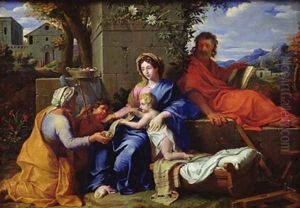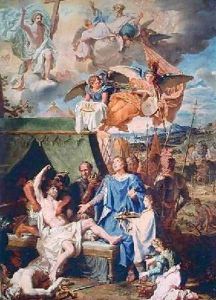Louis Licherie de Beuron Paintings
Louis Licherie de Beuron, born in 1629 in Paris, France, was a notable French painter of the 17th century, whose work predominantly reflects the Baroque style, characterized by its dramatic use of color, light, and shadow to evoke emotional responses. His artistic journey and contributions, although not as widely recognized as those of some of his contemporaries, played a significant role in the French Baroque movement, contributing to the rich tapestry of European art history.
Licherie's early life was marked by his immersion in the thriving artistic environment of Paris, where he received his initial training. The period was dominated by the influence of the Baroque, a style that originated in Italy but found a distinct expression in the hands of French artists. Licherie absorbed these influences, which would later be evident in his works that often depicted religious themes, a common subject matter for the era, rendered with a heightened sense of drama and emotion.
Throughout his career, Licherie received commissions from various religious institutions, which were a testament to his skill and the esteem in which he was held. His ability to convey complex biblical narratives through his paintings was particularly appreciated. Despite the prominence of religious themes, Licherie's work also included portraits and mythological subjects, showcasing his versatility as an artist.
Licherie's contribution to the French Baroque movement is also noted for his involvement in the decoration of several significant buildings and churches. These commissions provided him with the opportunity to work on a larger scale, creating immersive environments that exemplified the Baroque's grandeur and its ability to engage and move the viewer.
Louis Licherie de Beuron's death in 1687 marked the end of a career that, while perhaps not as celebrated as that of some of his peers, was nonetheless instrumental in the development of French Baroque art. His works remain as a testament to his skill and artistic vision, capturing the essence of an era that continues to fascinate and inspire. Though specific details of his life and work may not be as extensively documented as those of more famous artists, Licherie's legacy is preserved in the art he left behind, which continues to be appreciated by art historians and enthusiasts alike.

